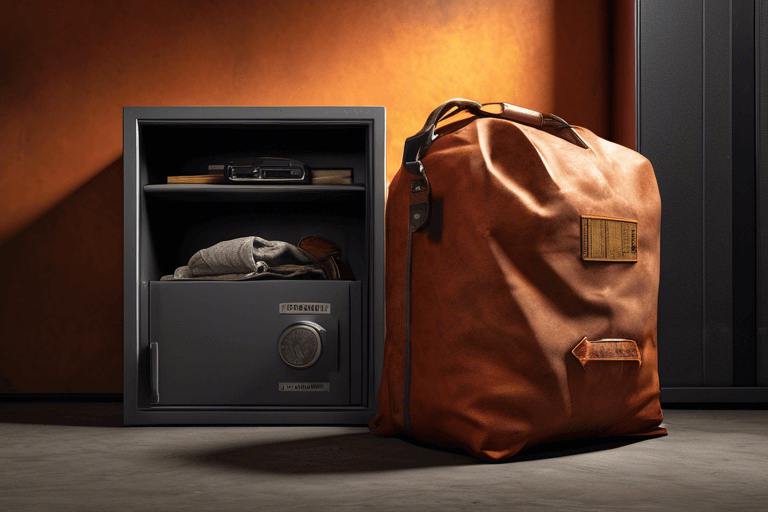
Fireproof Bags vs. Fireproof Safes: Which is Better?
When it comes to protecting valuable items from fire damage, two popular options come to mind: fireproof bags and fireproof safes.
These two solutions offer unique advantages and are often debated among enthusiasts.
In this guide, we will delve into the characteristics of fireproof bags and fireproof safes, explore their effectiveness, and help you make an informed decision on which option is best for your needs.
Fireproof Bags: Understanding the Technology
Fireproof bags are specifically designed to withstand high temperatures and protect valuable items from fire damage. These bags are made from heat-resistant materials such as Kevlar, fiberglass, ceramic, or silica cloth.
The key to their effectiveness lies in their multi-layered construction, which creates a barrier against extreme temperatures. When exposed to fire or high heat, the outer layers of the fireproof bag absorb and disperse heat, preventing it from penetrating through to the contents within.
Simultaneously, the inner layers reflect and resist the intense heat, creating a cooler environment inside the bag. This dual-action approach provides crucial protection for documents, electronic devices, and other sensitive items.
Fireproof Safes: A Higher Level of Protection
While fireproof bags offer a certain level of fire resistance, fireproof safes provide even greater protection. These safes are engineered to withstand high temperatures and keep their contents safe from fire damage. They typically come with fire ratings that define their ability to survive in a fire.
Fireproof safes are constructed with specialized materials and insulation that can withstand temperatures of up to 2,500 degrees Fahrenheit. These safes are designed to maintain a cool interior temperature so that the contents of the safe are kept well below their point of ignition, even in the event of a raging fire.
Additionally, fireproof safes offer theft protection, making them an all-in-one solution for storing valuables, important documents and emergency cash.
The Necessity of Using Both
While fireproof safes offer superior fire and theft protection, some individuals choose to use both a fireproof bag and a fireproof safe for added convenience and organization.
Placing a fireproof bag inside a fireproof safe allows for easy organization of the contents and provides an additional layer of protection.
By using both a fireproof bag and a fireproof safe, you can create a system that maximizes the safety and accessibility of your valuable items.
The fireproof bag can be used to store smaller items or documents that may need to be accessed more frequently, while the fireproof safe can securely store larger items or items that require enhanced protection.
Choosing the Right Option for Your Needs
When deciding between a fireproof bag and a fireproof safe, you'll want to consider your specific needs and the items you intend to protect. Here are some factors to consider:
1. Size and Capacity
Fireproof bags come in various sizes but are typically smaller than safes, so you'll want to ensure your chosen bag can accommodate the items you need to protect. Consider the dimensions and capacity of the bag to ensure it can hold all your valuables without overcrowding.
Similarly, fireproof safes come in different sizes and capacities as well. We always suggest taking into account current and future storage needs so that you have space for additional items over time. Many people regret not buying a larger safe the first time.
2. Accessibility
If you need frequent access to your items, a fireproof bag may be a more practical choice. Fireproof bags are portable and lightweight, allowing you to easily retrieve your valuables whenever needed.
However, if you prioritize maximum security and limited access, a fireproof safe is the better option. Fireproof safes offer enhanced protection against theft and are designed to be securely mounted or bolted down, adding an extra layer of security.
3. Level of Protection
Both fireproof bags and fireproof safes offer protection against fire damage, but fireproof safes provide a higher level of protection. If you have high-value items or irreplaceable documents, a fireproof safe is the best choice.
Fireproof safes are also resistant to other threats such as water damage and impact damage. They can withstand not only fire but also flooding or falling debris, ensuring the safety of your valuables in various scenarios.
So, Which is Best?
In conclusion, both fireproof bags and fireproof safes offer valuable protection against fire damage.
Fireproof bags are portable, lightweight, and offer a certain level of fire resistance, making them suitable for storing smaller items or documents.
On the other hand, fireproof safes provide superior fire and theft protection, making them ideal for storing high-value items or irreplaceable documents.
When deciding between a fireproof bag and a fireproof safe, consider your specific needs, the size and type of items you want to protect, and the level of accessibility you require.
Remember, investing in the right protection now can save you from the devastating loss of your cherished belongings in the future.
Frequently Asked Questions
Q: Are fireproof bags completely fireproof?
A: While fireproof bags are designed to withstand high temperatures, it's important to note that no bag is entirely fireproof. Fireproof bags offer a certain level of fire resistance, but their effectiveness may vary based on the intensity and duration of the fire.
Q: Can fireproof safes protect against theft?
A: Yes, fireproof safes are designed to protect against both fire and theft. They often come with additional security features such as digital keypad locks, biometric fingerprint scanners, or mechanical combination locks to ensure maximum protection for your valuables.
Q: Can fireproof bags be used to protect electronic devices?
A: Yes, fireproof bags are suitable for protecting electronic devices such as laptops, tablets, or hard drives. However, it's essential to choose a bag with a padded interior to provide additional shock absorption and protection against impact damage.



